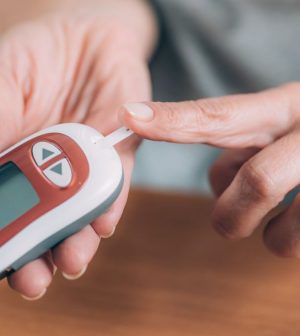- Navigating Your Midlife Crisis: Embracing New Possibilities
- City Raccoons Showing Signs of Domestication
- Mapping the Exposome: Science Broadens Focus to Environmental Disease Triggers
- One Week Less on Social Media Linked to Better Mental Health
- Your Brain Changes in Stages as You Age, Study Finds
- Some Suicide Victims Show No Typical Warning Signs, Study Finds
- ByHeart Formula Faces Lawsuits After Babies Sickened With Botulism
- Switch to Vegan Diet Could Cut Your Greenhouse Gas Emissions in Half
- Regular Bedtime Does Wonders for Blood Pressure
- Dining Alone Could Mean Worse Nutrition for Seniors
Number of Americans With Type 2 Diabetes Jumped by 20% in a Decade

Type 2 diabetes increased by nearly 20% in the United States between 2012 and 2022, with age, race, income level, obesity and lack of exercise all playing a role in the metabolic disease’s spread, a new study reports.
“Diabetes is increasing day by day in the U.S., and it will increase even more in the coming years,” said lead researcher Sulakshan Neupane, a doctoral student with the University of Georgia’s College of Agricultural and Environmental Sciences.
“Diabetes costs around $412 billion, including medical costs and indirect costs like loss of productivity,” Neupane added in a university news release. “That’s a huge amount, and it’s only going to increase as more people are diagnosed.”
Age is a major factor, with middle-aged people and seniors carrying a much higher risk of type 2 diabetes, researchers found.
Seniors aged 65 and older were more than 10 times as likely to be diagnosed with diabetes as people ages 18 to 24, results show. Middle-aged folks 45 to 64 were more than five times as likely to get such a diagnosis.
Income and education also played a role. People with high incomes were 41% less likely to develop type 2 diabetes, and the college-educated were 24% less likely.
Black people were the racial and ethnic group hardest hit by diabetes, with just under 16% diagnosed with the disease, researchers said.
The South and Midwest in particular experienced large jumps in type 2 diabetes cases, with Arkansas, Kentucky and Nebraska reporting the highest increases.
In all, 10 states experienced increases of 25% or more — Arkansas, Kentucky, Nebraska, Texas, Alabama, Minnesota, Illinois, West Virginia, Delaware and Massachusetts.
“In these areas, people are at higher risk of developing diabetes, so policymakers and public health officials need to focus on these regions,” Neupane said.
For the study, the researchers analyzed data from an ongoing national health survey of more than 400,000 people conducted by the U.S. Centers for Disease Control and Prevention.
Unsurprisingly, overweight and obese people were found to be at higher risk of type 2 diabetes, the data show.
About 1 in 5 obese people and 1 in 10 overweight people had type 2 diabetes in 2022, researchers found.
Physical activity seemed to provide effective protection against diabetes, results show. Just under 10% of physically active people reported having type 2 diabetes, versus a rate closer to 19% among people who are inactive, the study found.
The new study was published recently in the journal Diabetes, Obesity and Metabolism.
“Identifying these risk factors and acting to mitigate them is key,” Neupane said. “Be more active. Pay more attention to your physical health. Some risk factors like age and race cannot be modified, but you can do something to lower risk of diabetes, like healthy eating, maintaining an active lifestyle and losing weight.”
More information
Harvard Medical School has more about type 2 diabetes.
SOURCE: University of Georgia, news release, Aug. 21, 2024
Source: HealthDay
Copyright © 2025 HealthDay. All rights reserved.










